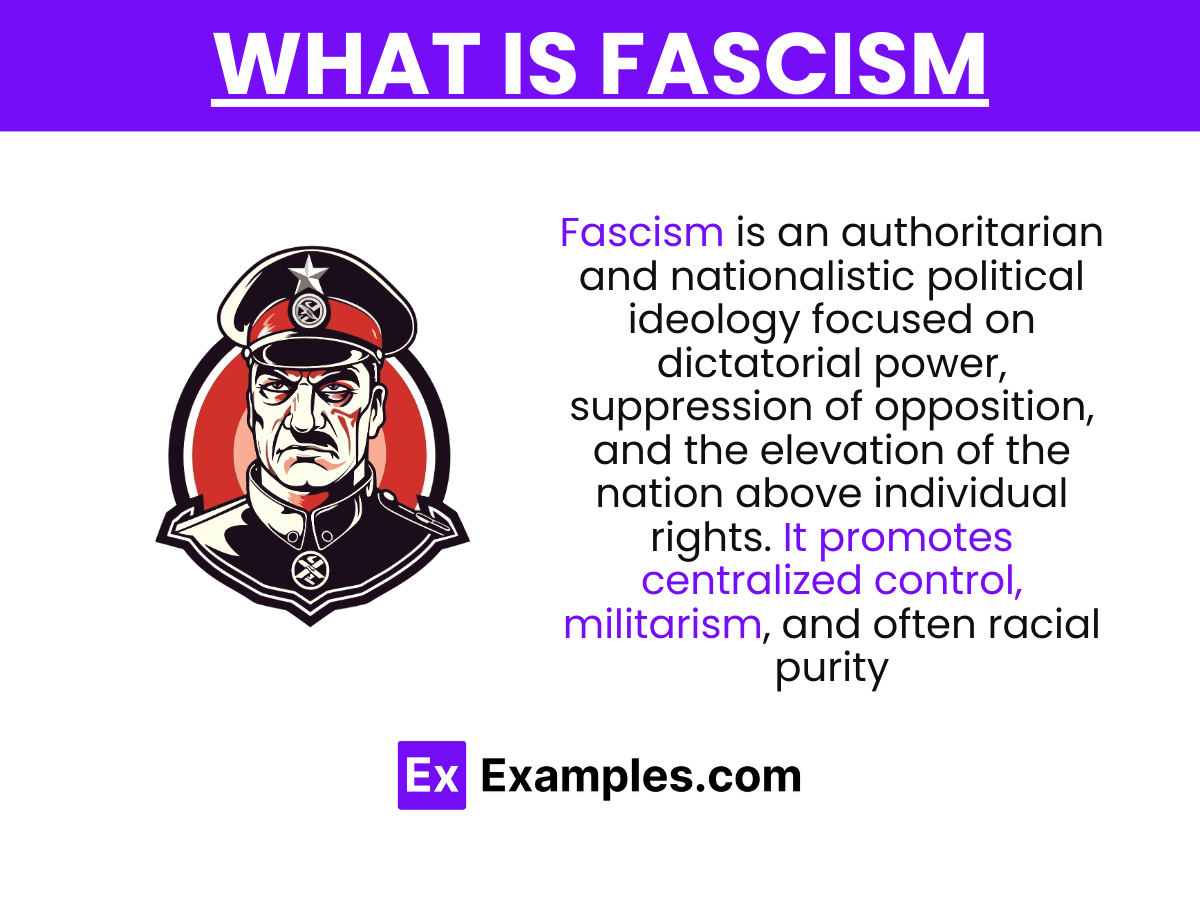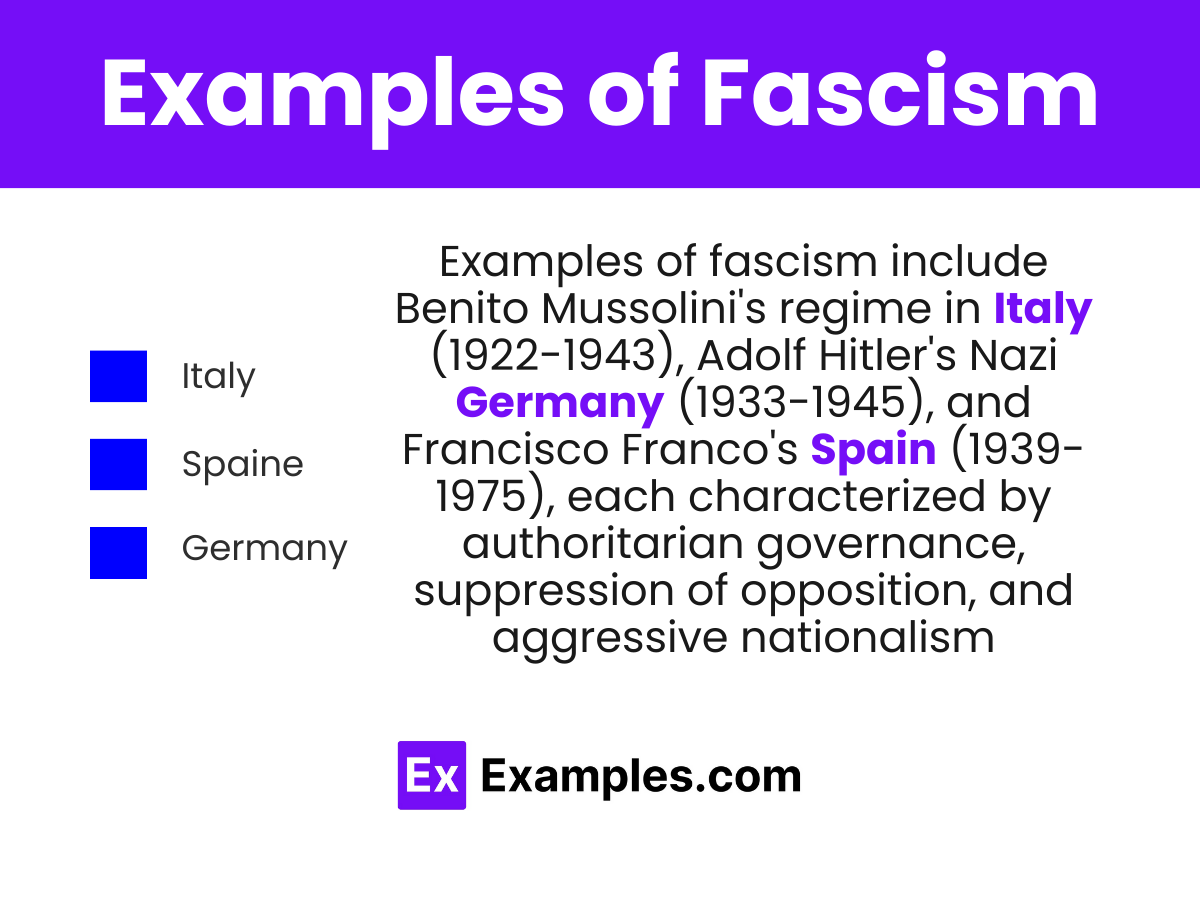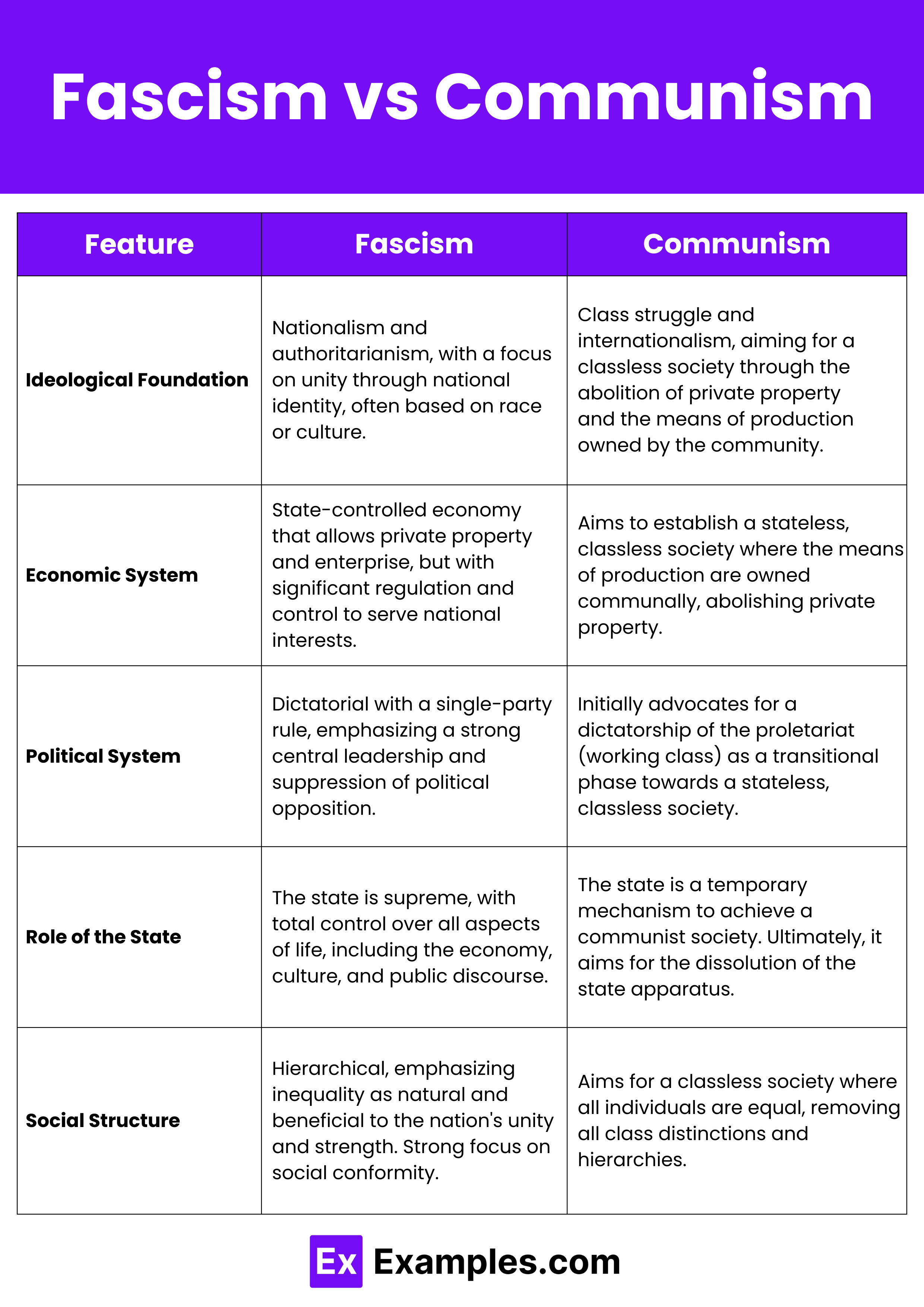Fascism Examples
The intricate world of Fascism, an ideology marked by authoritarian power and national supremacy. This guide delves into its historical emergence, key characteristics, and the profound impact it left on global politics. Through examples from Mussolini’s Italy to Hitler’s Germany, understand the allure and dangers of this ultranationalist movement. Discover how Fascism sought to forge unified, totalitarian states, emphasizing loyalty, and often leading to devastating consequences.
what is Fascism?
Fascism is a far-right, authoritarian ultranationalist political ideology and movement characterized by dictatorial power, forcible suppression of opposition, as well as strong regimentation of society and the economy. It emerged in early 20th-century Europe, with the most notable fascist regimes being led by Benito Mussolini in Italy from 1922 and Adolf Hitler in Germany from 1933. Fascism seeks to create a totalitarian state with a one-party rule, where nationalism is elevated to extreme levels, often coupled with racism, xenophobia, and the rejection of democratic principles. The economy under fascism is subject to state control, though private property may be allowed. The ideology also typically involves a cult of personality around the leader and the aggressive mobilization of the nation’s people through propaganda and mass rallies.
History of Fascism
Fascism’s history is marked by its emergence in the early 20th century, its role in leading to World War II, and its legacy and adaptations in the post-war era. Here’s a detailed breakdown:
Emergence in Post-World War I Europe
- Italy’s Lead: Fascism first took root in Italy post-World War I, with Benito Mussolini founding the Fascist Party in 1919. Mussolini’s “March on Rome” in 1922 resulted in his appointment as Prime Minister, leading to the establishment of a fascist dictatorship.
- Economic and Social Turmoil: The aftermath of World War I left many European countries in economic hardship and social unrest, creating fertile ground for radical political movements. Fascism appealed to many by promising national rejuvenation, stability, and a return to glory.
Spread and Influence
- Nazi Germany: Adolf Hitler, inspired by Mussolini, transformed the German Workers’ Party into the National Socialist German Workers’ Party (Nazi Party). Coming to power in 1933, Hitler established a totalitarian regime, emphasizing Aryan supremacy and leading to World War II and the Holocaust.
- Other Countries: Fascist movements also gained traction in countries like Spain, under Francisco Franco, and in lesser forms in Hungary, Romania, and elsewhere, each adapting fascism to their national context.
World War II and Decline
- Global Conflict: Fascist aggression by Germany, Italy, and Japan led to World War II. Fascist ideologies were directly responsible for immense atrocities, including the Holocaust.
- Defeat and Discredit: The defeat of the Axis powers in 1945 led to the disbandment of the fascist governments in Italy and Germany. The fascist ideology was discredited due to its association with war crimes and genocide.
Post-War Legacy and Neo-Fascism
- Post-War Scrutiny: After World War II, the world was vigilant about the resurgence of fascism. Trials, such as the Nuremberg Trials, sought to bring Nazi war criminals to justice, and new international bodies, like the United Nations, were established to prevent future conflicts.
- Neo-Fascism: Despite its discreditation, fascist ideologies have persisted in various forms, known as neo-fascism. These movements often emerge during times of social and economic instability, using nationalism, anti-immigration sentiments, and authoritarian policies to gain support.
Contemporary Fascism
- Modern Manifestations: In the 21st century, certain political parties and groups, often labeled as far-right, exhibit traits reminiscent of historical fascism, including nationalism, xenophobia, and calls for authoritarian governance.
- Global Response: The international community remains alert to the dangers of fascism, promoting democracy, human rights, and the rule of law as antidotes to authoritarian and ultranationalist ideologies
Features of Fascism
Fascism, as a political ideology, encompasses a range of characteristics and policies that are aimed at creating a totalitarian state. Here’s a detailed explanation of its key features:
Authoritarian Leadership
- Dictatorial Power: Fascism is marked by a single leader or a small group of leaders who possess absolute authority over the state. This leader often embodies the state itself and is the focal point of a personality cult.
- Suppressing Opposition: Any form of opposition or dissent is met with severe repression, including censorship, imprisonment, and violence, to maintain the regime’s power.
Ultra-Nationalism
- Extreme Nationalism: Fascism emphasizes aggressive patriotism and pride in one’s country, often to the exclusion or detriment of other nations and cultures.
- Ethnic Superiority: Many fascist regimes advocate for the superiority of their ethnic group, leading to policies of racial discrimination, xenophobia, and in extreme cases, genocide.
Centralized Control
- Totalitarian Ambitions: Fascist governments seek to control all aspects of life, including political, social, and economic activities, aiming for total authority over the society.
- State Control of the Economy: While private ownership may be allowed, the state exerts tight control over the economy, directing production, consumption, and distribution to serve the interests of the state.
Militarism and Expansionism
- Militarization of Society: Fascism glorifies military strength and values, encouraging a martial spirit among its citizens and the integration of military and civilian sectors.
- Imperialist Goals: Fascist states often pursue aggressive expansionist policies, seeking to enlarge their territory through conquest and colonization.
Propaganda and Mass Mobilization
- Use of Propaganda: Fascist regimes heavily rely on propaganda to control public opinion, glorify the leader, and promote their ideology, often through manipulation of media and the arts.
- Mass Rallies and Demonstrations: Large-scale rallies and public demonstrations are frequently used to show support for the regime and to unify the population under fascist ideals.
Opposition to Liberal Democracy and Socialism
- Rejection of Democratic Principles: Fascism opposes liberal democracy, criticizing its perceived weakness, indecisiveness, and division. It advocates for a one-party state to ensure national unity and strength.
- Anti-Socialist: While fascism incorporates some socialist rhetoric about community and collective action, it vehemently opposes Marxist socialism and communism for their class struggle ideology and internationalism, favoring instead a national community unified by race or nationalist identity.
Examples of Fascism
Fascism, as a political ideology, has manifested in various forms throughout the 20th century. Here, we explore some of the most notable examples of fascist regimes, highlighting their characteristics and impacts.
Fascist Italy under Benito Mussolini
- Rise to Power: Benito Mussolini founded the Fascist Party in Italy in 1919, coming to power in 1922 after the March on Rome. He established the first fascist regime, declaring himself Il Duce (The Leader).
- Government Structure: Mussolini abolished democratic institutions, establishing a one-party totalitarian state. The regime emphasized aggressive nationalism, expansionism (notably in North Africa), and the cult of personality.
- Economic and Social Policies: Implemented corporatism, aiming to create a collaborative relationship between employers and employees under state supervision, to prevent class conflict and promote national unity.
Nazi Germany under Adolf Hitler
- Rise to Power: Adolf Hitler, leader of the National Socialist German Workers’ Party (Nazi Party), became Chancellor of Germany in 1933. He quickly transformed the Weimar Republic into a totalitarian state.
- Ideology and Policies: Hitler’s regime was characterized by extreme anti-Semitism, leading to the Holocaust, aggressive expansionism culminating in World War II, and the promotion of Aryan racial superiority.
- Totalitarian Control: The Nazis controlled all aspects of life in Germany, including the economy, media, and education, using propaganda and the secret police (Gestapo) to eliminate opposition.
Spain under Francisco Franco
- Spanish Civil War: General Francisco Franco led the Nationalists to victory in the Spanish Civil War (1936-1939), establishing a fascist dictatorship that lasted until his death in 1975.
- Regime Characteristics: While not purely fascist, Franco’s regime shared many features, such as authoritarianism, nationalism, and anti-communism. It relied on the military, the Catholic Church, and the Falange (Spain’s fascist party) for support.
- Impact: Franco’s rule was marked by repression of political opponents, censorship, and economic policies aimed at self-sufficiency. Spain remained neutral in World War II but maintained close ties with other fascist leaders.
Other Fascist-Influenced Regimes
Several other regimes have been influenced by fascist ideology, adapting its principles to fit their own contexts. These include:
- Portugal under António de Oliveira Salazar: Salazar’s Estado Novo (New State) regime (1933-1974) emphasized nationalism, authoritarianism, and anti-communism, maintaining a conservative social order with the support of the Catholic Church.
- Japan during World War II: While not purely fascist, Imperial Japan shared similarities with fascist regimes, including militarism, expansionism, and a state-controlled economy, under the guise of creating a Greater East Asia Co-Prosperity Sphere.
Fascism vs Communism
| Feature | Fascism | Communism |
|---|---|---|
| Ideological Foundation | Nationalism and authoritarianism, with a focus on unity through national identity, often based on race or culture. | Class struggle and internationalism, aiming for a classless society through the abolition of private property and the means of production owned by the community. |
| Economic System | State-controlled economy that allows private property and enterprise, but with significant regulation and control to serve national interests. | Aims to establish a stateless, classless society where the means of production are owned communally, abolishing private property. |
| Political System | Dictatorial with a single-party rule, emphasizing a strong central leadership and suppression of political opposition. | Initially advocates for a dictatorship of the proletariat (working class) as a transitional phase towards a stateless, classless society. |
| Role of the State | The state is supreme, with total control over all aspects of life, including the economy, culture, and public discourse. | The state is a temporary mechanism to achieve a communist society. Ultimately, it aims for the dissolution of the state apparatus. |
| Social Structure | Hierarchical, emphasizing inequality as natural and beneficial to the nation’s unity and strength. Strong focus on social conformity. | Aims for a classless society where all individuals are equal, removing all class distinctions and hierarchies. |
| Attitude Towards Democracy | Rejects liberal democracy and pluralism, viewing them as weak and divisive. Favors authoritarian governance to ensure national unity. | Views parliamentary democracy as a tool of the bourgeoisie class. Advocates for a revolutionary approach to achieve a direct, classless democracy. |
| International Outlook | Expansionist and militaristic, seeking to increase the nation’s power and territory. Often xenophobic and hostile to international cooperation seen as undermining national sovereignty. | Internationalist, promoting worldwide revolution to spread communism. Believes in solidarity among the working classes across nations. |
| Key Examples | Nazi Germany under Adolf Hitler, Fascist Italy under Benito Mussolini, and Francoist Spain under Francisco Franco. | Soviet Union under Lenin and Stalin, Communist China under Mao Zedong, and Cuba under Fidel Castro. |
Fascism vs Dictatorship
| Feature | Fascism | Dictatorship |
|---|---|---|
| Definition | A far-right, authoritarian ultranationalist ideology and movement characterized by dictatorial power, forcible suppression of opposition, and strong regimentation of society and the economy. | A form of government where a single leader or group holds absolute power, without effective constitutional limitations. |
| Ideological Basis | Fascism is based on extreme nationalism, often coupled with racism, and aims to create a totalitarian state that controls all aspects of life. | Dictatorships can be ideologically neutral or aligned with various political ideologies, including communism, fascism, or even democracy in the form of a ‘benevolent dictatorship’. |
| Governance | Led by a single leader who embodies the state and its ideology. The government seeks to control all aspects of public and private life, promoting a unified national community. | Power is centralized in the hands of a single ruler or a small group. Governance structures and the extent of control over society can vary widely. |
| Economic System | The state often controls the economy to serve national interests, with policies that can include corporatism or state intervention in the market. | Economic policies can vary widely, from free-market capitalism to state-controlled economies, depending on the dictator’s objectives. |
| Political System | Fascism rejects democratic governance, advocating for a one-party state with absolute power vested in the leader. | Dictatorships may emerge from various political systems and can maintain a facade of democracy, such as sham elections, or dispense with it altogether. |
| Society and Culture | Emphasizes uniformity, order, and national greatness, often at the expense of minority groups. Propaganda is used extensively to promote the fascist ideology. | Social and cultural policies depend on the dictator’s preferences, with some promoting nationalism and others focusing on personal power or ideological goals. |
| Examples | Fascist Italy under Benito Mussolini, Nazi Germany under Adolf Hitler. | North Korea under Kim dynasty, Zimbabwe under Robert Mugabe, Iraq under Saddam Hussein. |
Fascism FAQ?
What is Fascism?
Fascism is a far-right, authoritarian ideology marked by dictatorial power, extreme nationalism, suppression of opposition, and often, racial superiority ideologies.
How Did Fascism Start?
Fascism emerged in early 20th-century Europe, notably in Italy with Benito Mussolini, as a response to political and economic instability post-World War I.
What Are Key Features of Fascism?
Key features include authoritarian leadership, totalitarian ambitions, ultra-nationalism, suppression of opposition, militarism, and control over society and the economy.
How is Fascism Different from Communism?
Fascism and communism differ fundamentally in ideology: fascism emphasizes extreme nationalism and often racial purity, while communism advocates for class struggle and a stateless society.
Can Fascism Exist Today?
While traditional fascist regimes are less common today, neo-fascist movements can emerge, often characterized by authoritarianism, nationalism, and xenophobia.
What Was the Impact of Fascism?
Fascism led to massive human rights abuses, the Holocaust, and contributed significantly to the outbreak of World War II, leaving a lasting impact on global history.
Fascism represents a distinct authoritarian ideology marked by dictatorial power, stringent societal control, and extreme nationalism. Characterized by its opposition to democracy and liberal values, fascism’s historical instances—most notably in Mussolini’s Italy and Hitler’s Germany—underscore its potential for oppression and violence. Understanding fascism’s features and impacts is crucial for safeguarding democratic principles and human rights in the face of authoritarian threats.





